AMD Midrange Gaming
Let's start by pointing out the pink elephant hiding in the corner: there's no doubt that Intel has faster processors than anything AMD is currently shipping. Intel also has CPUs that overclock (percentage wise) a lot better than anything AMD currently offers. So why even bother considering AMD? There are several reasons. Price is the biggest attraction, which extends beyond the price of the CPU to the price of the platform as a whole. The other major consideration is that if you're talking about a gaming system, for the vast majority of systems the graphics card is going to be the most important aspect of gaming performance. The features you can get at a particular price point for an AMD setup are also very good. Now that that's out of the way....
| AMD Midrange Gaming System |
| Hardware |
Component |
Price |
Rebates |
| Processor |
Athlon 64 X2 5000+ AM2 Black Edition (2.6GHz 2x512K unlocked) - Retail |
$130 |
|
| Motherboard |
ASUS M2N32-SLI Deluxe WiFi (nForce 590 SLI) |
$167 |
|
| Memory |
Patriot Extreme Performance 2x1GB PC2-8500 (PDC22G8500ELK) |
$139 |
$25 |
| Video Card |
XFX GeForce 8800GTS 320MB (PVT80GGHF4) |
$287 |
$20 |
| Hard Drive |
Western Digital Caviar SE16 320GB 7200RPM 16MB (WD3200AAKS) |
$80 |
|
| Optical Drive |
Samsung 20X DVD+R SATA (SH-S203B) |
$36 |
|
| Case |
Cooler Master Centurion 534 (RC-534-KKN2-GP) |
$66 |
$10 |
| Power Supply |
Corsair CMPSU-520HX |
$108 |
$10 |
| Display |
Acer AL2216Wbd 22" 5ms (1680x1050) |
$235 |
|
| Speakers |
Logitech X-530 5.1 70W Speakers |
$66 |
|
| Keyboard |
Saitek Eclipse USB Wired (PZ30AU) |
$40 |
|
| Mouse |
Logitech G5 Wired Adjustable Weight |
$52 |
$15 |
| Operating System |
Windows Vista Home Premium 32-bit (OEM) |
$105 |
|
| Bottom Line |
$1511 |
$1431 |
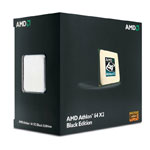 |
The core of any system is the motherboard and processor, and we've gone with AMD's latest X2 5000+ Black Edition sitting snugly in an ASUS M2N32-SLI Deluxe WiFi motherboard. The Black Edition's claim to fame of course is its unlocked multiplier, giving overclockers a little bit more flexibility. We've seen reports online of people hitting 3.4 GHz and beyond with a bit of effort. While just about any midrange Core 2 Duo processor will offer better performance at maximum stable overclock, the X2 5000+ is still relatively inexpensive and offers competitive stock performance. If you don't care about the unlocked multiplier, a regular X2 5000+ costs $10 less.
If you're undecided on what CPU or platform might be best, you might want to take a look at our
Midrange CPU Roundup from a couple weeks back. As long as you're willing to take overclocking out of the picture, you can get performance that's relatively competitive with Intel's Core 2 Duo E4400/E4500 with a CPU price that's nearly identical to the E4400 - or about $13 cheaper if you get the standard 5000+. Looking specifically at the gaming results from that article, performance tends to fall between those same two processors, at least at 1024x768 where we aren't GPU limited. If you're like most people and you plan to play at higher resolutions (for example 1680x1050 if you purchase the recommended LCD), performance differences are going to be even smaller.
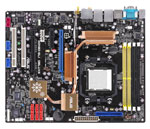 |
The ASUS motherboard offers SLI support, which might be something useful in the future, but for a midrange system we're going to stick with single graphics cards for now. The ASUS M2N32 Deluxe WiFi also comes with a bevy of overclocking options, ASUS' proven reputation, and integrated 802.11b/g WiFi support for good measure. If you will make use of all of these features, the final price is very good; if you don't need WiFi or dual x16 PEG slots, you can get basically the same performance and features for around $95 with the DFI Infinity NF570-M2/G.
As mentioned, the graphics card is probably the most important component for this type of system, and we had quite a few choices. We decided to go with a GeForce 8800 GTS 320MB, as it offers the most attractive price/performance ratio. Other than minor differences in factory clock speeds, all of the 8800 GTS cards are pretty similar, so the deciding factor was price. XFX ended up getting the nod, but EVGA, Gigabyte, Leadtek, and others are not too far off.
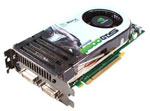 |
It's important to point out the runner-up cards that we didn't choose as well, as other factors might actually make them a better choice in the long-run. The 8800 GTS 320MB performs identically to the 640MB version, up until the point where you run out of graphics memory. Right now, that usually only happens at extreme resolutions like 2560x1600 or in a few certain games with maximum texture quality (which often doesn't bring a noticeable improvement in visual quality). That's right now, however; next-generation games could very likely push 320MB cards to the limit, particularly when we consider that 512MB cards have been shipping for a couple of years now. We have seen preliminary results on next-gen titles where the 640MB cards hold a pretty substantial performance advantage, so if you can spare the extra money that's probably the safer bet.
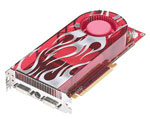 |
The other option is AMD's recently launched HD 2900 Pro, which in theory carries a similar price to the 8800 GTS 320MB. The drawback here is that the cards aren't readily available right now, and while this is an AMD platform we're using an NVIDIA chipset. MSRP is supposed to be around $250, but the few places that even have cards in stock are charging a price premium. Since the cards seem to be downclocked 2900 XT GPUs, you can probably get some pretty good overclocking results, but many people are simply interested in stock performance. You also get a $20 mail-in rebate on the GTS 320MB, and HD 2900 cards tend to really suffer when antialiasing is enabled. Finally, AMD and NVIDIA both have upcoming midrange cards that could very well improve performance while staying under the $250 price point; since these cards are not yet available, however, they will have to wait for a future Buyers' Guide.
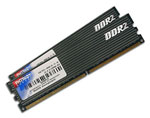 |
We're not going to spend a lot of time dwelling on the rest of the components, as many of them have been discussed in previous Buyers' Guides and/or reviews. We did choose to use some DDR2-1066 memory, which honestly might be overkill considering the price. $114 (after rebate) for 2GB of this type of memory might seem like a steal compared to a year ago, but if you're okay with DDR2-800 you can still pick up 2GB of 4-4-4 memory for a measly $75. In fact, one of the AnandTech editors did exactly that just this last week... twice! If you're thinking about upgrading to a 64-bit operating system, give some serious thought to running a 4GB configuration with DDR2-800 as opposed to 2GB of higher performance DDR2-1066.
The final price comes out to $1511 (not counting rebates). Depending on how you want to configure things, going with an AMD platform will save you somewhere between $15 and $100 compared to a similar Intel configuration. By no means is our AMD platform bad, but if we were to go out and purchase a midrange gaming system right now, it would be using a Core 2 Duo processor. Then again, we're enthusiasts, so overclocking is pretty much a given. If you can hold on a couple more months, we're definitely interested in some of the changes that will occur with AMD's upcoming product launches. The attraction of current AM2 systems is mostly price, and the gap there is really too small these days to make it a real deciding factor.















41 Comments
View All Comments
JarredWalton - Wednesday, October 17, 2007 - link
And naturally, this is not a one-size-fits-all thing. Some people would rather have 8GB of DDR2-667 than 4GB of DDR2-800 (or whatever). I tried to get this across in the RAM commentary - it really *IS* overkill depending on what you intend to do. For a budget system, yeah, you can skip the DDR2-800 and save $13 if you want; midrange or overclocking? Decent DDR2-800 is as cheap as I'm going. Serious midrange overclocking, I'll go for DDR2-1066, which I'd also use for a high-end system. If you want absolute maximum overclocking and performance and screw the cost? Then I guess we can bring in the DDR3-1800 stuff. LOLPirks - Wednesday, October 17, 2007 - link
Yeah, I'd ratrher go for 4GB of cheap DDR2-667 RAM 'cause I like to keep lots of open apps in Vista x64 and since some games started to hit 2GB barrier - go figure. And 4GB of high quality DDR2-1066 RAM is somewhat a waste for a gaming rig, it's better to invest in 8800GTX and cool 28" LCD screen for this kind of stuffhubajube - Tuesday, October 16, 2007 - link
A ATI card on a workstation machine?sdsdv10 - Thursday, October 18, 2007 - link
That's not a comment, it's question. Hence the question mark "?". ;-)rallycobra - Tuesday, October 16, 2007 - link
Vostro 200 with 1.6ghz duo, 1gig ram with Vista on eBay $280WD 500gb SE16 $115
2 gigs crucial ram after MIR $45.
Nvidia 8800GT 256 or 512mb ~$250 at the end of the month. (GTS speed)
conductive paint to pin mod cpu to 2.67ghz $0 (already have a tube!)
Not a bad PC for $650!!!
Pick up a 24" monitor for $300 in the hot deals forum...
JarredWalton - Tuesday, October 16, 2007 - link
For the record, a modded E2140 overclocked to 2.66GHz is not the same as the E6550. If you're going to go cheap, it's a reasonable option, but 1MB of cache on the Core 2 architecture really does hurt performance quite a bit. I'm not sure about how that will work in a Dell motherboard anyway, but I guess if you know what you're doing with the conductive paint....Anyway, this is still meant as a midrange guide, using parts that are available now. I pointed out quite a few changes that could be made to get the price down on the systems - including using cheaper memory and a less expensive motherboard. I'm not going to recommend eBay for a Buyer's Guide for a variety of reasons (just like I don't recommend refurbished/used hardware), but others can use them if they want.
If I were to try to piece together a Dell-equivalent using parts similar to yours, I'd likely get a final price of around $750 (just eye-balling things). I'd also consider it to be a very budget-oriented gaming system, where many corners are cut and overclocking is used in order to keep costs down. That's fine for some users, but a lot of people do appreciate nicer cases, accessories, and a high quality PSU. We'll hopefully have a budget guide out sometime soon, where you will see prices and components similar to what you've mentioned (though not using eBay or Dell still).
FrankThoughts - Tuesday, October 16, 2007 - link
Excellent! eBay, MIRs, CPU hacking all in one alternative... Yeah, we should all buy those! If you're going to get a Dell you probably don't want to upgrade the thing right after. A similar Vostro 200 system to what was listed comes to $1300, not including the 8800 GTS, DDR2-800/1066, or a decent motherboard. Then there's the case, power supply, keyboard, and mouse.Cheap case and PSU: $50
2GB DDR2-800 RAM: $75
320GB HDD: $80
Cheap mobo (ASUS P5B SE): $95
E2140: $75
DVDR: $30
8800GT: $250
Vista: $105
Cheap (Dell equivalent) keyboard and mouse: $15
Total: $775
You saved $125 with your MIR, apparently. Congratulations! Personally I'll pass on that budget setup. Have fun with your system, though. Hope it all works properly. I'd be hesitant to try running an 8800GTS or 8800GT when it comes out off of a 300W Dell power supply!
Calin - Tuesday, October 16, 2007 - link
"$114 (after rebate) for 2GB of this type of memory might seem like a steel compared to a year ago"I think it night seem like a copper :)
Yawgm0th - Tuesday, October 16, 2007 - link
There's plenty to question about the HTPC system.IMHO You can basically go one of a couple ways with an HTPC. You go high-def or you don't. You go DVR or you don't. Those choices greatly affect what parts you get.
If you're going to have an optional BD drive listed, why not list a GeForce 8600 as well? I know you discuss it later on the page, but it would make a lot more sense to put it on the table as "optional". It's practically mandatory IMO if you need HD output. Yeah, you can usually do 1080i and 720p okay without it, but it does help, and it really is necessary IMO for 1080p.
For a DVR, with HDTV and any digital TV in mind, as well as general quality -- terrible tuner choices. This is accentuated by the recent article on the new AMD TV Wonder cards. Recommending the PCI-E 650 makes the most sense by far.
If one isn't going HD, then the HTPC changes greatly. MicroATX is overkill unless it's a DVR. At this point you're best of switching to Mini-ITX. Via and Intel both have some great offerings for a DVR in this sector. Noise is important, as you say, and nothing beats mini-ITX when it comes to noise (except maybe SBCs and nano-ITX). A passively cooled mini-ITX can easily handle any mpeg2 or mpeg4 variants while leaving a very small footprint.
For a non-HD DVR/HTPC a digital tuner and low-end mATX system with an IGP is the way to go. That seems to be where the system in the article is headed, but the inclusion of talk about Blu-Ray and 1080p and whatnot confuses things substantially. Even without that, the price is far higher than one should expect for a system of this sort due to some of the component choices.
Overall, I find the HTPC system to lack direction or a clear sense of purpose. What is "mid-range" in the HTPC world? What makes an HTPC? The ability to play a variety of media files from a variety of sources, or the inclusion of one or more TV tuners, thus making it a DVR?
IMO what really needs to happen is a Buyer's Guide specifically for HTPCs. There are a variety of uses for HTPCs specifically just for "home theaters" and not as DVRs, and there are multiple DVR configurations that make sense. Hinting at different possibilities in one "mid-range" guide for an HTPC just doesn't do it.
Also, I will stress that a good sound card is a must for an HTPC. You don't need to be an audiophile to appreciate good sound quality. Although these days quite a few motherboards come with very nice integrated 5.1 and 7.1, not as many come in mATX flavor, and some of the add-in sound cards do make substantial improvements. Anyone with a decent surround system should notice a decrease in sound quality if they try to run anything through an HTPC that doesn't have a good sound card.
OrSin - Tuesday, October 16, 2007 - link
I have to disagree with Mini-ITX. Its great platform, but the has some limits.First it will never do DVR or HD. I know you stated that, but not being about to upgrade to some basic functions down the road is a killer for me.
Second most case don't allow for large hard drives. Again it might not be necessary if you storage other places or an external array, but again this basic limitation is akiller for me. You can get a bigger case, but at that piont why not for a M-ATX and limit your future needs. I own a Mini-ATX and had to move it to a second HTPC function. Acutally I own 2, and one is my daughter system. If you have a HTPC that doubles as media server in a closet some where, and a mini-itx as frout end unit in Living room then its a nice set up, but as stand alone its lacking (for me anyway).
Even using it in a threate room was lacking for me since most projector you want to do 1080p, since on a 110' screen you actually tell the difference from 720p.